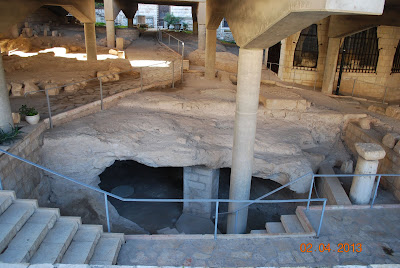As I said in the previous blog, instead of showing photos
from the first day’s tour, then the second day and the third day, I am separating the blogs into the different
periods of Jesus’s life. The previous
blog was about our visit to his birthplace in Bethlehem after starting at the
Mount of Olives. This blog will be about
Nazareth, where he grew up and the cities and countryside around the north end
of the Sea of Galilee where he spent most of his adult life and preformed many
of his miracles.
This trip to
Nazareth and the Sea of Galilee took all day because of the distance from
Jerusalem and Tel Aviv. We left
Jerusalem at 6 a.m. on the tour bus headed for Tel Aviv to pick up others on
the tour, then north along the
Mediterranean Sea until eventually cutting northeast to Nazareth. Nazareth consists of an old Nazareth and a
New Nazareth, governed by separate mayors.
During Jesus’s time it was a small village whereas today it is a large
city, mostly Muslim as you can see by the sign shown below. Upon reaching Nazareth we visited the
Basilica of the Annunciation which is built on the site of four earlier
churches from the 4th century to the present church built in
1969. It sits on what is thought to be
the home of Christ’s mother, Mary. The
Church has some exposed archeological excavations where you can view streets and remains of
buildings from the time of Christ. Near
to it is Mary’s well, where the Angel Gabriel appeared to Mary to announce that
she was to be the mother of the son of God. Also nearby
is St. Joseph Church which is built above where Jesus’s earthly father Joseph
had his carpentry shop and their home.
Unfortunately it was closed so we were unable to see it.
Remember to click on each photo to enlarge it.
The Basilica of the Annunciation
Inside the Basilica
Archeological excavations under the Basilica
St. Joseph Church where Joseph's carpentry shop was located.
Muslim sign viewed while walking to the Basilica
From Nazareth we
traveled northeast to the northern shores of the Sea of Galilee and the village
of Capernaum or Capharnaum where Jesus spent much of his adult life. Before arriving there, we drove through the
resort city of Tiberias and on the Tabgha.
Tabgha is the location where Christ fed the multitudes with the loaves
and fish. The Church of the
Multiplication of the Loaves and Fishes is built on the site of a 4th
century Byzantine church. In front of
the altar is a 5th century mosaic depicting the loaves and fish and under the
altar is the stone where Christ supposedly placed them.
Inside the Church of the Multiplication of the Loaves and Fishes
From outside of the Church of the Multiplication can be seen
Mount of Beatitudes where Christ preached the Sermon on the Mount. Nearby is the Roman Catholic Church of the
Beatitudes.
Mount of Beatitudes
A short distance
away at the north end of the Sea of Galilee are the remains of the village of
Capernaum or Capharnaum, the spelling depends on the pamphlet or sign you
read. The area is comprised of black basalt rock. Any white stone in this area was brought in. This is where Christ spent much of
his adult life. Four of his disciples,
Peter, Andrew, James and John were from this village along with Matthew, the
tax collector being there. A fish from the Sea of
Galilee is named the Saint Peter fish and is served in the restaurants in the
area. We had it for lunch and it was
delicious! The village consists of
churches and remains of houses from that time period as well as a later
synagogue built sometime after the 1st century over the site where
the synagogue stood where Jesus is believed to have taught. A present day church is built over the
location of Peter’s home.
Entrance to Capharnaum
Remains of Capharnaum
Synagogue
Synagogue and city remains
Inside the Synagogue
Wall of the original Synagogue used by Jesus
Peter's house identified by 1st century graffiti
Returning
to the tour bus we then drove along the western shore of the Sea of Galilee
southward. Looking east across the Sea of Galilee we could see the Golan Heights and Syria. Further south there was a rift in the mountains which was the border between Syria and Jordan.
Across the Sea of Galilee are the Golan Heights and Syria

Across is Syria on the left and Jordan on the right

As we continued our journey south to the point the Sea of Galilee ends and flows into the River
Jordan, we visited the Yarndenit
Baptismal site, one of the many disputed sites on the Jordan River where John
the Baptist baptized Jesus. The Jordan
River is a very small river and would be referred to as a large creek in
Kentucky. Very peaceful though. Full of catfish and muskrats both of which
will gather in front of you if you have something to feed them.
River Jordan

John the former Baptist with his hand in the River Jordan

Catfish and muskrats begging for food in the River Jordan

Driving to Nazareth and returning along the same route, we
passed the archeological site of Armageddon -- the site on the distant hill with the scattered trees is where the last battle on earth is to
take place between the forces of good and evil (as foretold in revelation 16). I would like to have stopped but being on a
tour bus, you go where the guide takes you.
Armageddon















No comments:
Post a Comment